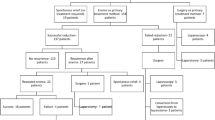Abstract
Background
Sonography has been used to predict pneumatic reduction outcome in children with intussusception.
Objective
To assess the prognostic significance of fluid between the intussusceptum and intussuscepiens with respect to reduction outcome, lead point or necrosis.
Materials and methods
Sonograms of children with a discharge diagnosis of intussusception from four institutions were reviewed for interloop fluid and correlated with results of pneumatic reduction and surgical/pathological findings when available. Maximal dimension of interloop fluid on a transverse image and fluid complexity were evaluated.
Results
Of 166 cases, 36 (21.7%) had interloop fluid. Pneumatic reduction was successful in 21 (58.3%) with fluid and 113 (87.6%) without. The average largest fluid dimension was 8.7 mm (range 5 mm–19 mm, median 8 mm) in cases with successful reduction and 12.8 mm (range 4 mm–26 mm, median 12.5 mm) in unsuccessful reduction (p < 0.05). Fluid dimension equal to or greater than 9 mm correlated with failed reduction (p < 0.0001;odds ratio13:1). In 36 cases with interloop fluid that required surgery, there were four lead points and three necrosis. In cases without fluid with surgical reduction, there was one lead point and one necrosis. Interloop fluid correlated with lead point (p < 0.04) or necrosis (p < 0.03). Its significance increased with larger amounts of fluid (p < 0.0001). Patient age/fluid complexity did not correlate with reduction outcome (p = 0.9).
Conclusion
Interloop fluid was associated with increased failure of pneumatic reduction and increased likelihood of lead point or necrosis, particularly when the maximum dimension exceeded 9mm.




Similar content being viewed by others
References
Swischuk LE, Stansberry SD (1991) Ultrasonographic detection of free peritoneal fluid in uncomplicated intussusception. Pediatr Radiol 21:350–351
Britton I, Wilkinson AG (1999) Ultrasound features of intussusception predicting outcome of air enema. Pediatr Radiol 29:705–710
Verschelden P, Filiatrault D, Garel L et al (1992) Intussusception in children: reliability of US in diagnosis-a prospective study. Radiology 184:741–744
Lim HK, Bae SH, Lee KH et al (1994) Assessment of reducibility of ileocolic intussusception in children: usefulness of color Doppler sonography. Radiology 191:781–785
Feinstein KA, Myers M, Fernbach SK et al (1993) Peritoneal fluid in children with intussusception: its sonographic detection and relationship to successful reduction. Abdom Imaging 18:277–279
Wood SK, Kim JS, Suh SJ et al (1992) Childhood intussusception: US guided hydrostatic reduction. Radiology 182:77–80
Koumanidou C, Vakaki M, Pitsoulakis G et al (2002) Sonographic detection of lymph nodes in the intussusception of infants and young children: clinical evaluation and hydrostatic reduction. AJR 178:445–450
Stranzinger E, Dipietro MA, Yarram S et al (2009) Intramural and subserosal echogenic foci on US in large-bowel intussusceptions: prognostic indicator for reducibility? Pediatr Radiol 39:42–46
Del-Pozo G, González-Spinola J, Gómez-Ansón B et al (1996) Intussusception: trapped peritoneal fluid detected with US—relationship to reducibility and ischemia. Radiology 201:379–386
Mirilas P, Koumanidou C, Vaakaki M et al (2001) Sonographic features indicative of hydrostatic reducibility of intestinal intussusception in infancy and early childhood. Eur Radiol 11:2576–2580
Kirks DR (1994) Diagnosis and treatment of pediatric intussusception: how far should we push our radiologic techniques? Radiology 191:622–623
Navarro OM, Daneman A, Chae A (2004) Intussusception: the use of delayed, repeated reduction attempts and management of intussusceptions due to pathologic lead points in pediatric patients. AJR 182:1169–1176
Author information
Authors and Affiliations
Corresponding author
Rights and permissions
About this article
Cite this article
Gartner, R.D., Levin, T.L., Borenstein, S.H. et al. Interloop fluid in intussusception: what is its significance?. Pediatr Radiol 41, 727–731 (2011). https://doi.org/10.1007/s00247-010-1931-0
Received:
Revised:
Accepted:
Published:
Issue Date:
DOI: https://doi.org/10.1007/s00247-010-1931-0




